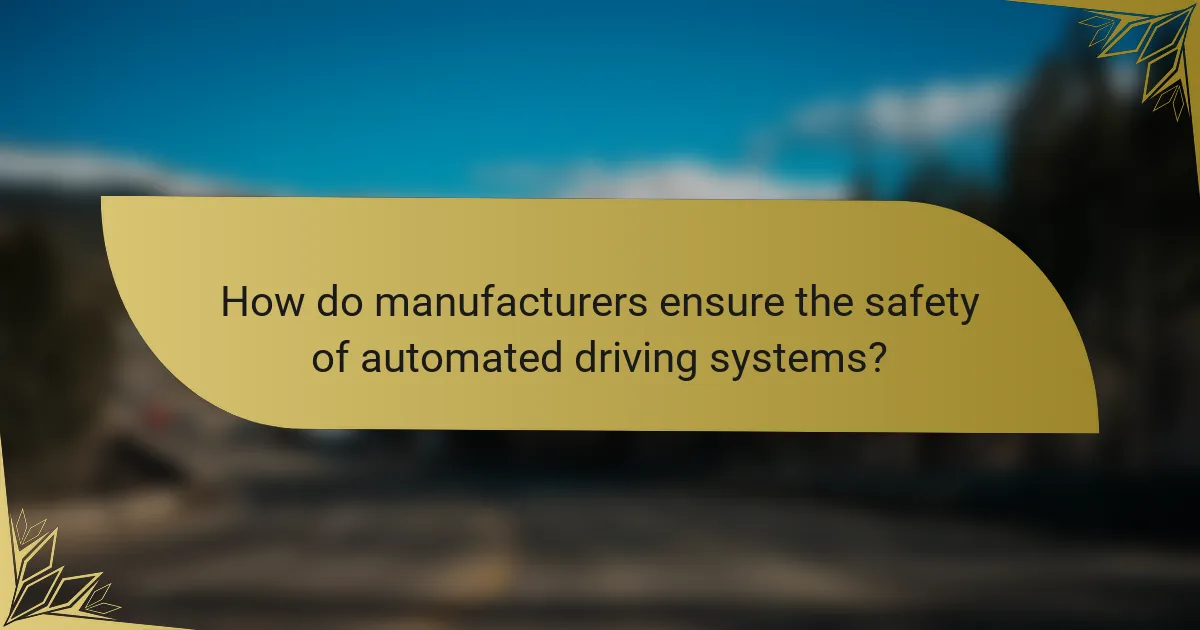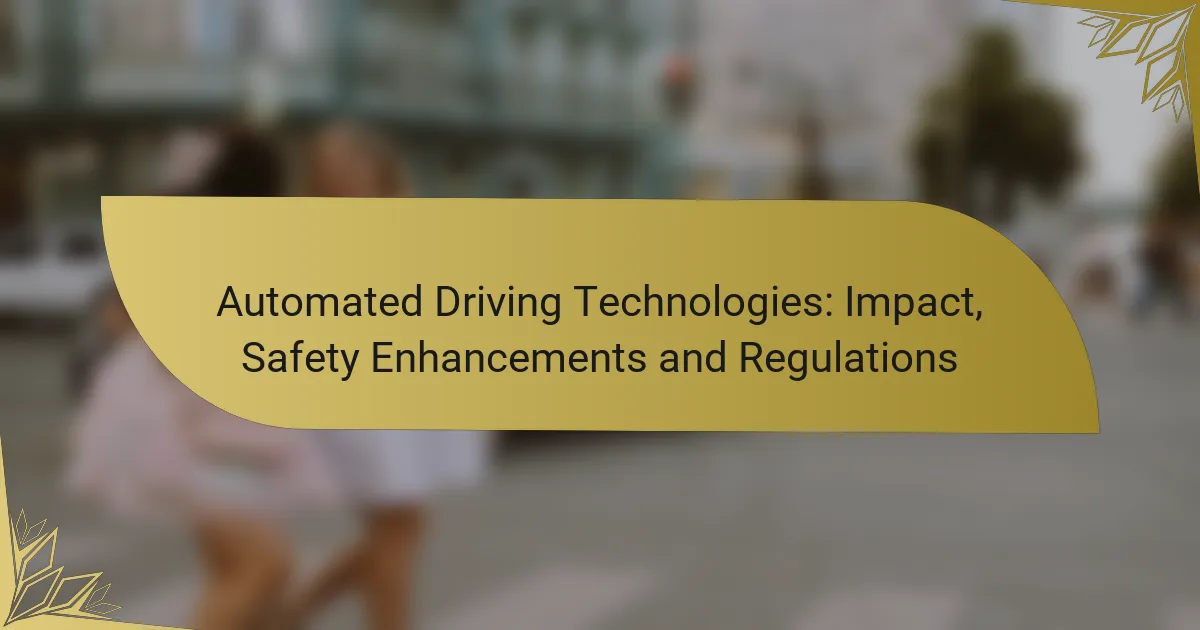Automated driving technologies are revolutionizing road safety by minimizing human error, a primary factor in traffic accidents. By leveraging advanced sensors and algorithms, these systems enhance vehicle performance and safety while navigating complex environments. As regulations evolve to balance innovation and safety, the potential benefits of automated driving extend beyond individual vehicles to reshape transportation systems and urban planning.

How do automated driving technologies enhance safety in vehicles?
Automated driving technologies significantly enhance vehicle safety by reducing human error, which is a leading cause of accidents. These systems utilize advanced sensors and algorithms to monitor surroundings, predict potential hazards, and respond accordingly.
Collision avoidance systems
Collision avoidance systems are designed to detect obstacles in a vehicle’s path and take preventive action. They use sensors like radar and cameras to identify potential collisions and can automatically steer or brake to avoid an accident.
For example, many modern vehicles come equipped with forward collision warning systems that alert drivers of imminent dangers. If the driver does not respond in time, the system can engage the brakes, reducing the severity of a collision or preventing it altogether.
Adaptive cruise control
Adaptive cruise control maintains a set speed while automatically adjusting to the speed of the vehicle ahead. This technology enhances safety by ensuring a safe following distance, which helps prevent rear-end collisions.
When the vehicle in front slows down, adaptive cruise control reduces speed accordingly. Once the road is clear, it accelerates back to the preset speed, allowing for a more relaxed driving experience without compromising safety.
Lane-keeping assistance
Lane-keeping assistance helps drivers stay within their lane by providing steering support or alerts when the vehicle drifts. This system uses cameras to monitor lane markings and can gently steer the vehicle back into the lane if necessary.
While useful, drivers should remain attentive, as lane-keeping assistance is not a substitute for active driving. It is most effective on well-marked highways and roads, making it crucial to ensure proper lane visibility.
Emergency braking systems
Emergency braking systems automatically apply the brakes when a potential collision is detected, significantly reducing stopping distances. These systems are particularly effective in urban environments where sudden stops are common.
Many emergency braking systems can detect pedestrians and cyclists, providing an additional layer of safety. However, drivers should be aware that these systems may not always react to every situation, so maintaining vigilance is essential.

What are the current regulations for automated driving in the United States?
Current regulations for automated driving in the United States involve a combination of federal standards and state-specific laws. These regulations aim to ensure safety while promoting innovation in automated vehicle technologies.
Federal Motor Vehicle Safety Standards
The Federal Motor Vehicle Safety Standards (FMVSS) establish essential safety requirements for all vehicles, including automated ones. These standards cover various aspects such as crashworthiness, performance, and equipment requirements, ensuring that automated vehicles meet safety benchmarks similar to traditional vehicles.
As automated driving technologies evolve, the National Highway Traffic Safety Administration (NHTSA) is actively updating guidelines to address new challenges. Manufacturers must demonstrate compliance with FMVSS before their vehicles can be sold or operated on public roads.
State-specific legislation
State-specific legislation regarding automated driving varies significantly across the United States. Some states have enacted comprehensive laws that outline the testing and deployment of automated vehicles, while others have limited or no regulations in place.
For instance, states like California and Arizona have established frameworks that allow for extensive testing of autonomous vehicles, including requirements for safety drivers and reporting incidents. In contrast, some states may only permit limited testing or impose strict liability on manufacturers for accidents involving automated vehicles.

What are the benefits of automated driving technologies?
Automated driving technologies offer significant advantages, including enhanced safety, increased accessibility, and improved traffic efficiency. These benefits can lead to a transformative impact on transportation systems and urban planning.
Reduced traffic accidents
One of the primary benefits of automated driving technologies is the potential for reduced traffic accidents. By utilizing advanced sensors and algorithms, these systems can react faster than human drivers, minimizing the likelihood of collisions. Studies suggest that fully autonomous vehicles could reduce accidents by a substantial percentage, potentially saving thousands of lives each year.
To maximize safety, automated systems often incorporate features like automatic emergency braking, lane-keeping assistance, and adaptive cruise control. These technologies work together to prevent common causes of accidents, such as distracted driving and impaired judgment.
Increased mobility for disabled individuals
Automated driving technologies can greatly enhance mobility for individuals with disabilities. By providing independent transportation options, these systems enable users who may not be able to drive to access essential services, employment, and social activities. This increased mobility can lead to improved quality of life and greater inclusion in society.
For instance, ride-sharing services that utilize automated vehicles can be designed with accessibility features, such as wheelchair ramps and voice-activated controls, making them user-friendly for people with various disabilities. This shift towards inclusivity is essential for fostering equitable transportation solutions.
Improved traffic flow
Automated driving technologies can significantly improve traffic flow by optimizing vehicle movements and reducing congestion. These systems can communicate with each other and traffic infrastructure to coordinate speeds and routes, leading to smoother traffic patterns. This coordination can decrease travel times and reduce fuel consumption, benefiting both drivers and the environment.
For example, connected vehicles can adjust their speeds in real-time based on traffic conditions, preventing bottlenecks and minimizing stop-and-go scenarios. Implementing these technologies in urban areas can lead to more efficient use of road networks and a reduction in overall traffic delays.

What challenges do automated driving technologies face?
Automated driving technologies encounter several significant challenges that hinder their widespread adoption. Key issues include public acceptance, cybersecurity threats, and regulatory hurdles that must be addressed to ensure safe and effective deployment.
Public acceptance and trust
Public acceptance is crucial for the success of automated driving technologies. Many individuals remain skeptical about the safety and reliability of self-driving vehicles, often due to high-profile accidents or a lack of understanding of the technology. Building trust involves transparent communication about safety measures and real-world performance.
To foster acceptance, manufacturers can engage in public demonstrations, educational campaigns, and partnerships with local communities. Providing clear information about how these systems work and their safety benefits can help alleviate concerns.
Cybersecurity threats
Cybersecurity is a major concern for automated driving technologies, as vehicles become increasingly connected to networks. Potential threats include hacking, data breaches, and unauthorized access to vehicle systems, which could compromise safety and privacy. Manufacturers must prioritize robust security measures to protect against these vulnerabilities.
Implementing strong encryption, regular software updates, and intrusion detection systems are essential steps in safeguarding automated vehicles. Collaborating with cybersecurity experts can also enhance resilience against evolving threats.
Regulatory hurdles
Regulatory hurdles pose significant challenges for the deployment of automated driving technologies. Different countries and regions have varying laws and standards, which can create confusion and slow down the approval process. Navigating these regulations requires a thorough understanding of local requirements and compliance standards.
To overcome regulatory challenges, companies should actively engage with policymakers and participate in discussions about developing frameworks that support innovation while ensuring safety. Establishing pilot programs can also help demonstrate the technology’s benefits and facilitate regulatory acceptance.

How do manufacturers ensure the safety of automated driving systems?
Manufacturers ensure the safety of automated driving systems through a combination of rigorous testing, adherence to safety standards, and collaboration with regulatory authorities. These processes help identify and mitigate risks associated with automated vehicles before they are deployed on public roads.
Rigorous testing protocols
Manufacturers implement extensive testing protocols that include simulations, closed-course testing, and real-world driving scenarios. These tests assess system performance under various conditions, such as adverse weather, complex traffic situations, and unexpected obstacles.
Testing often follows established guidelines, such as those set by the Society of Automotive Engineers (SAE) for levels of automation. This structured approach ensures that vehicles can safely navigate diverse environments and respond appropriately to potential hazards.
Collaboration with regulatory bodies
Collaboration with regulatory bodies is crucial for the development and deployment of automated driving technologies. Manufacturers work closely with agencies like the National Highway Traffic Safety Administration (NHTSA) in the U.S. to align their safety protocols with national regulations and standards.
Such partnerships facilitate the sharing of data and best practices, helping to shape policies that govern automated vehicles. This cooperation ensures that safety measures are not only effective but also compliant with evolving legal frameworks, enhancing public trust in these technologies.

What are the implications of automated driving technologies on urban planning?
Automated driving technologies significantly influence urban planning by necessitating changes in infrastructure, land use, and traffic management. As these technologies evolve, cities must adapt to enhance safety, efficiency, and accessibility for all users.
Redesign of road infrastructure
The integration of automated driving technologies requires a comprehensive redesign of road infrastructure to accommodate vehicles that operate without human intervention. This includes the installation of advanced sensors, dedicated lanes, and improved signage to facilitate communication between vehicles and road systems.
Urban planners must consider the spatial requirements of automated vehicles, which may differ from traditional cars. For example, wider lanes and optimized intersections can enhance traffic flow and safety, reducing the need for extensive parking spaces as ride-sharing becomes more prevalent.
Additionally, cities should prioritize the development of smart traffic management systems that utilize real-time data to optimize traffic signals and reduce congestion. Implementing these changes can lead to more efficient urban environments and improved public safety.
